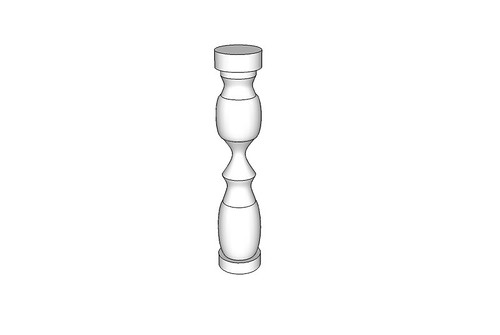Alright, here's how I did it. Keep in mind I used the raw DXF import from the manufacturer for this. Normally I lighten the profile a lot by redrawing the curves using fewer segments. I figure you can do that part easily enough so I bypassed it here.
First the imported profile.
Next, I drew three lines across the profile. The first one cause the faces to be filled. I placed the lines so as to separate the square sections from the round. Then I copied the rectangular faces off to one side. I moved the copies a known distance so I could move them back later. The green is my back face color.
Next I deleted all but half of the profiles. I use a few guidelines to show where I needed to draw lines to refill the faces. In order to make the pommels later, I extended the curves outward to the guides that are parallel to the red axis. The distances for this aren't critical. You just need to make sure the profile will intersect the square portion of the profile properly.
Before drawing the rest of the lines back in to refill the faces, I ran weld.rb on the profiles. This saves a lot of time later because I won't need to smooth the rings around the legs later.
After running weld, I added the lines in to complete the faces.
Push/Pull makes quick work of the square portions of the leg. Instead of plling the entire height in one step, I pulled up half way and then orbited around to the bottom and pulled down the rest of the way.. This kept the square sections on the same line as the impending turnings. The boxes could have been pulled in one step and then moved down, instead.
I also added a circle for the Follow Me path. Note that it is larger than the diameter of the leg. It doesn't matter what size the circle is as long as it is centered on the centerline of the profile. I deleted the face keeping only the circle's edge. The circle is drawn right at the end of the leg. If the faces was kept, Follow Me might leave a hole in the bottom of the leg. Without the face, on the circle, there will definitely be a face on the bottom of the leg after Follow Me.
Finally, I reversed the faces of the profiles. It is faster to do it now than to do it after the leg is completed.
After Follow Me we have this:
The square sections are moved into place.
At this point I scaled the model up by a factor of 100 to avoid the tiny face syndrome. To scale the model up, I drew a short line segment 1" long off to one side. Then I measured that line with the Tape Measure tool. It measured one inch but I entered 100 in the VCB and hit Enter. SU asked if I wanted to resize the model to which I answered, 'Yes.'
Then I ran Intersect with model. Because of the huge number of entities in this one, I dragged selection boxes around the areas where the intersections needed to be made and ran Intersect. So this was done once for each intersection.
I deleted the waste after the intersections to get to this point.
Finally, I rotated the leg to the vertical position and then made it a component. Doing those things in that order makes it easy to get the component axes oriented properly.
And there you have a finished leg. It goes much more rapidly for me when I don't have to make screen grabs but even so, I finished up in under 5 minutes.





















